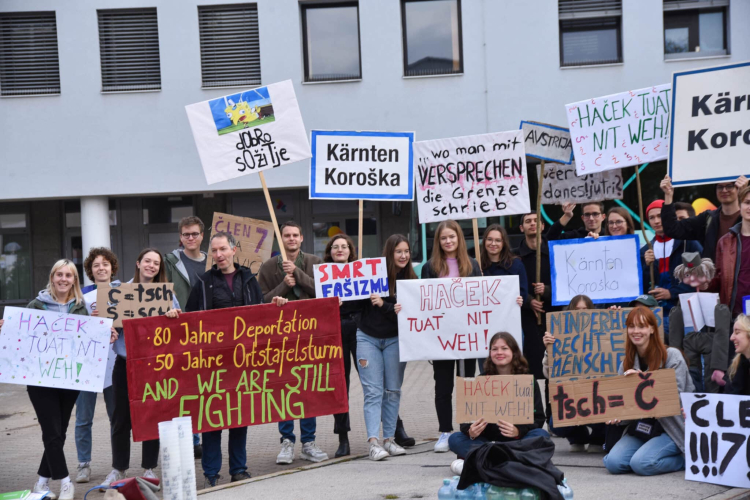Antifascist Activism and Educational Work by Carinthian-Slovenian Students
10.04.2025

The Carinthian Slovenes are often a silenced minority in the culture of remembrance. In Carinthia/Koroška, the primacy of remembrance applies to the "Abwehrkampf" (defensive battle) – the mythologized defense against the "Slavic aggressor" after the First World War. German glory is inscribed in stone, streets and calendars. In 2024, in the center of Klagenfurt/Celovec, a memorial plaque was installed for the provincial administrator and anti-Slavic Arthur Lemisch. [1]
Through educational and awareness-raising campaigns and a general public presence, ethnic Slovenians in Carinthia/Koroška oppose this single-perspective understanding of history. In Vienna/Dunaj, the struggle for minority-sensitive remembrance is often much more difficult.
Carinthian Slovenes were a minority persecuted by the National Socialists. Around 200 Slovenian families were deported to German forced labor camps, the Slovenian language was banned, books were burned, priests and intellectuals were transferred from Slovenian communities, and the ethnic group structures were dissolved. After the escape of Slovenian members of the Wehrmacht and conscripts and their participation in isolated acts of sabotage, the organized armed resistance of the Carinthian Slovenes was launched in 1942. They went "into the forest", to the Osvobodilna fronta. [2] The armed resistance of the partisans was a decisive argument for the establishment of the Second Republic after the end of the war. However, neither the resistance nor the history of the victims of the Carinthian Slovenes found a place in Austria's official historical narrative.
Instead of waiting for Austria to finally incorporate minority histories into school curricula, create a school subject on minorities, commemorate them at the state level or erect central monuments, minorities are creating their own structures. The KSŠŠD in Vienna/Dunaj is committed to ongoing anti-fascist commemoration work. The association organizes the annual "Antifascist Winter/Antfašistična zima", during which various aspects of history and the antifascist struggle are discussed in lectures, readings and performances. With actions and demonstrations, the association, in cooperation with other organizations, repeatedly addresses grievances such as the Ustaša meeting in Bleiburg/Pliberk, the celebrations around 10 October, and the ongoing non-fulfilment of Article 7 of the State Treaty of Vienna. In 1972 the association organized MAD (Mladinski akcijski dan/Youth Action Day) on the occasion of the 50th anniversary of the local Orstafelsturm (storm on place name signs). Students and young people spent a day driving through places in Carinthia/Koroška where minority rights have not been fulfilled, giving speeches, erecting bilingual place name signs and being surrounded by police.
Educational work within and outside their own structures is one of the most important means of survival for the Slovenian ethnic group. After all, remaining an isolated individual is a privilege that minorities often cannot afford – we think in terms of generations.
[1] Fugger, Stephan. 2024. "Gedenktafel für Arthur Lemisch am Alten Platz wurde enthüllt", Mein Bezirk.
[2] DÖW. O.D. The Carinthian Slovenes.
Ana Grilc
Association of Slovenian Students in Vienna/Dunaj
Photo © Franc Wakounig
Empfohlen

The Gunskirchen concentration camp was a satellite camp of Mauthausen about which little was known for a long time; it existed only in the final months of the war and the events there were barely documented. Reports and photos from the liberators were the first and for many years the only evidence of the horrors in the "Hochholz" (high timber). In addition, there are no structural remains that would indicate the existence of the concentration camp.
